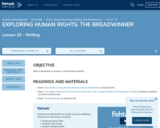
Write a paragraph to answer a unit essential question.
- Subject:
- English Language Arts
- Material Type:
- Homework/Assignment
- Lesson Plan
- Author:
- Fishtank Learning
- Date Added:
- 05/26/2021

Write a paragraph to answer a unit essential question.

Write a magazine article that informs readers about a key theme from the unit by stating a claim and providing evidence from the entire unit.

These assessments accompany this unit to help gauge student understanding of key unit content and skills.
The Content Assessment pushes students to synthesize unit content knowledge or unit essential questions in writing. The Content Assessment should be used as the primary assessment because it shows mastery of unit content knowledge and standards.
The Cold-Read Assessment tests students' ability to read a "cold" or unfamiliar passage and answer multiple choice questions. The Cold-Read Assessment can be given in addition to the Content Assessment as a pulse point to what students can read and analyze independently, a skill often required for standardized testing.
Each assessment should take approximately one class period. If giving both assessments, schedule two days for assessments.
The Fluency Assessment measures students’ ability to read a grade-level text with accuracy and prosody, at a proficient rate. Teachers should use the information gathered from the assessment to monitor students’ fluency and plan for any necessary intervention groups. This assessment is quick and should happen at the end of a unit. Teachers should plan to pull students one-on-one to do this while the rest of the class is independently reading or writing.
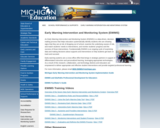
Early Warning Intervention and Monitoring System (EWIMS) is an evidence-based, data-driven, decision-making process that is often leveraged as part of a district’s Multi-tiered System of Supports framework. Within the process schools use a continuum of tiered supports for students (Tier 1, Tier 2, Tier 3), each with demonstrated evidence of effectiveness. At Tier 1, schools implement evidence-based practices to support attendance, positive social emotional and behavioral well-being and high course performance for all learners. EWIMS also helps educators systematically identify students who are showing signs that they are at risk of dropping out of school. EWIMS examines the underlying causes of risk, matches student needs to interventions, and monitors student progress and the success of the interventions. Fundamentally EWIMS is an ongoing cycle of examining data and making decisions about supports and interventions to help students get back on track for graduation.
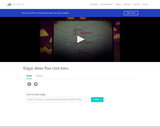
Students will view this slideshow online as the first activity in a blended unit. The activity is meant to introduce the author and some of his works, including several that the students will read as part of the unit. It is primarily intended to spark student interest in the unit. However, it will also aid the students in that they will be better poristioned to read the author's works if they have some sense of what to expect in terms of themes.
The choice to include such as introductory tool into the unit was based upon prior observations regarding the difficulty of getting students engaged in any lesson when nothing had been done to sprak their interest beforehand.
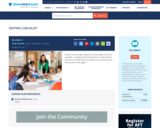
Stickers to encourage children to read through their work and edit it - looking at particular elements in their writing - they check off when they can evidence it; and teachers can do the same if they agree!
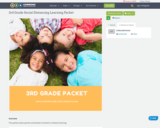
This packet assists parents and teachers transition to distance learning.

Student demonstration of analysis of literary elements in fiction and nonfiction.
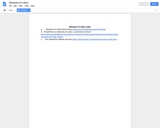
For this lesson students will learn the different parts of the elements of a story. They will be able to watch a catchy movie explaining the parts and apply their knowledge to an interactive website.
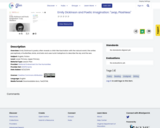
Emily Dickinson's poetry often reveals a child-like fascination with the natural world. She writes perceptively of butterflies, birds, and bats and uses lucid metaphors to describe the sky and the sea.

In this lesson, students revise their pourquoi tales with a specific focus on comparative and superlative adverbs (L.3.1g). While student work may or may not feature comparative and superlative adverbs, this is a time to learn and practice the rules associated with the use of these words.
In Opening A, students' Mid-Unit 1 Assessments are returned with feedback. The purpose of this is for students to have the opportunity to see how they performed in order to improve in their next assessment, and to ask questions if they don't understand the feedback.
Not much time has been given to the revision of pourquoi tales for comparative and superlative adverbs, as it is unlikely that students will have many examples or opportunities for examples in their tales.
It is unlikely that all students will be able to read their narratives in this lesson. As a result, time has been allocated for Frog Festival, Part II in Lesson 14. Divide the group accordingly.
In this lesson, the habit of character focus is working to become ethical people. The characteristic they are reminded of specifically is respect, as they will be participating in the Frog Festival and will need to be respectful performers and audience members.
The research reading students complete for homework helps to build both their vocabulary and knowledge pertaining to frogs and specifically frog adaptations. By participating in this volume of reading over a span of time, students will develop a wide base of knowledge about the world and the words that help describe and make sense of it.
Some students practice their fluency in this lesson by reading their pourquoi tale aloud during the Frog Festival.
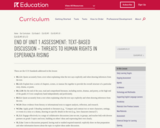
In this lesson, students complete the end of unit assessment, in which they complete two different tasks: having a group discussion about the threats to human rights in Chapters 4-6 of Esperanza Rising (RL.5.1, RI.5.1, W.5.9a, SL.5.1, SL.5.1a, SL.5.1b, SL.5.1c) and answering short response questions requiring students to quote accurately from the text and to examine how the structure of "Las Cebollas" contributes to the overall structure of the novel (RL.5.1, RL.5.1).
To hear all students discuss, create groups of five and provide 7 minutes for each group's discussion. When students are not involved in the discussions, they should complete Part II of the assessment independently.
After the end of unit assessment, students reflect on their learning using the Tracking Progress: Collaborative Discussion recording form. This exercise is meant to provide them with time to formally keep track of and reflect on their own learning. This self-reflection supports metacognition and pride in work and learning.
In this lesson, the habit of character focus is on working to become an ethical person. The characteristics that students practice are respect, empathy, and compassion, as they participate in a text-based discussion, and integrity, as they work independently on assessments.
The research reading that students complete for homework will help build both their vocabulary and knowledge pertaining to human rights. By participating in this volume of reading over a span of time, students will develop a wide base of knowledge about the world and the words that help describe and make sense of it.
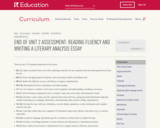
In these two lessons, students complete the End of Unit 2 Assessment, Parts I and II. In Part I, students read aloud a new excerpt from The Most Beautiful Roof in the World (RF.5.4). In Part II, they write a literary analysis essay to answer the question: "What does the use of concrete language and sensory detail help you understand about the rainforest?" (RL.5.1, W.5.2, W.5.9a).
The assessment is spread over two lessons to provide students the time to plan and write their literary analysis essay (Part II) and to provide the time to assess each student individually as they read aloud the excerpt of text (Part I).
Since the assessment is spread over two lessons, students should complete the Tracking Progress: Informative Writing recording form during the Closing and Assessment A at the end of Lesson 13. At the end of Lesson 12, students should use this time to reflect on their work in Lesson 12 using the Tracking Progress: Informative Writing form to see how they can improve in the next lesson. Completing the tracking progress recording form is meant to provide students with time to formally keep track of and reflect on their own learning. This self-reflection supports metacognition and pride in work and learning.
The research reading that students complete for homework helps build both their vocabulary and knowledge pertaining to the rainforest, specifically rainforest species and research. By participating in this volume of reading over time, students will develop a wide base of knowledge about the world and the words that help describe and make sense of it. Inviting students to share what they have been learning through independent reading holds them accountable.
In this lesson, the habit of character focus is working to become an effective learner. The characteristic students are reminded of specifically is perseverance, as they will be working independently on their assessments, which may be challenging for some of them.
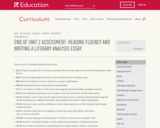
In these two lessons, students complete the End of Unit 2 Assessment, Parts I and II. In Part I, students read aloud a new excerpt from The Most Beautiful Roof in the World (RF.5.4). In Part II, they write a literary analysis essay to answer the question: "What does the use of concrete language and sensory detail help you understand about the rainforest?" (RL.5.1, W.5.2, W.5.9a).
The assessment is spread over two lessons to provide students the time to plan and write their literary analysis essay (Part II) and to provide the time to assess each student individually as they read aloud the excerpt of text (Part I).
Since the assessment is spread over two lessons, students should complete the Tracking Progress: Informative Writing recording form during the Closing and Assessment A at the end of Lesson 13. At the end of Lesson 12, students should use this time to reflect on their work in Lesson 12 using the Tracking Progress: Informative Writing form to see how they can improve in the next lesson. Completing the tracking progress recording form is meant to provide students with time to formally keep track of and reflect on their own learning. This self-reflection supports metacognition and pride in work and learning.
The research reading that students complete for homework helps build both their vocabulary and knowledge pertaining to the rainforest, specifically rainforest species and research. By participating in this volume of reading over time, students will develop a wide base of knowledge about the world and the words that help describe and make sense of it. Inviting students to share what they have been learning through independent reading holds them accountable.
In this lesson, the habit of character focus is working to become an effective learner. The characteristic students are reminded of specifically is perseverance, as they will be working independently on their assessments, which may be challenging for some of them.
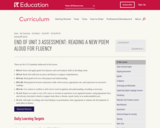
In this lesson, students begin by analyzing the model poetry presentation with photographs in order to understand why the poet chose those photographs and how the photographs contribute to the audience's understanding of what inspired the poem (SL.4.5).
Students then select images for their own presentations and revise their presentations to include references to the images (SL.4.5). As they do this, students are called on to individually read aloud for the teacher a new poem for fluency for the End of Unit 3 Assessment.
It will probably take more than one lesson to listen to all students read aloud, so two lessons have been allocated for this. If students finish choosing images and revising their presentations to include those images, they can practice presenting with their images.
During the Closing and Assessment, students reflect on their learning using the Tracking Progress: Reading Fluency recording form. This exercise is meant to provide them with time to formally keep track of and reflect on their own learning. This self-reflection supports metacognition and pride in work and learning.
In this lesson, the habits of character focus is on working to become an effective learner and working to become an ethical person. The characteristics that students are reminded of specifically are perseverance as they read aloud a new poem/excerpt of a poem for the End of Unit 3 Assessment, and respect as they bring in visuals (photographs, videos and objects) from home.
The research reading that students complete for homework will help build both their vocabulary and knowledge pertaining to poetry and creative writing. By participating in this volume of reading over a span of time, students will develop a wide base of knowledge about the world and the words that help describe and make sense of it.
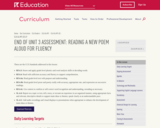
In this lesson, students begin by analyzing the model poetry presentation with photographs in order to understand why the poet chose those photographs and how the photographs contribute to the audience's understanding of what inspired the poem (SL.4.5).
Students then select images for their own presentations and revise their presentations to include references to the images (SL.4.5). As they do this, students are called on to individually read aloud for the teacher a new poem for fluency for the End of Unit 3 Assessment.
It will probably take more than one lesson to listen to all students read aloud, so two lessons have been allocated for this. If students finish choosing images and revising their presentations to include those images, they can practice presenting with their images.
During the Closing and Assessment, students reflect on their learning using the Tracking Progress: Reading Fluency recording form. This exercise is meant to provide them with time to formally keep track of and reflect on their own learning. This self-reflection supports metacognition and pride in work and learning.
In this lesson, the habits of character focus is on working to become an effective learner and working to become an ethical person. The characteristics that students are reminded of specifically are perseverance as they read aloud a new poem/excerpt of a poem for the End of Unit 3 Assessment, and respect as they bring in visuals (photographs, videos and objects) from home.
The research reading that students complete for homework will help build both their vocabulary and knowledge pertaining to poetry and creative writing. By participating in this volume of reading over a span of time, students will develop a wide base of knowledge about the world and the words that help describe and make sense of it.
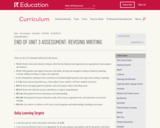
In this lesson, students complete the End of Unit 3 Assessment. In Part I, they answer selected-response questions about forming and using verbs in the perfect tense. For Part II, they revise their monologue group's Directors' Note for task, purpose, and audience and for use of verbs in the perfect tense. Note that even though students wrote this text as a group, they will work independently to revise and edit it for the assessment. As they work on Parts I and II, they will be called to work one-on-one on Part III of the assessment: reading aloud an excerpt from Esperanza Rising (W.5.4, W.5.5, L.5.1b, RF.5.4).
It may take more than one lesson to listen to all students read aloud, so more time has also been allocated in the next lesson for Part III of the assessment.
In this lesson, the habit of character focus is on working to become an effective learner. The characteristic that students are reminded of specifically is perseverance as they work through their assessment independently.
The research reading that students complete for homework will help build both their vocabulary and knowledge pertaining to human rights. By participating in this volume of reading over a span of time, students will develop a wide base of knowledge about the world and the words that help describe and make sense of it.
How it builds on previous work:
Students revised their monologues for use of the perfect verb tenses and for task, purpose, and audience earlier in the unit. In this lesson, they are assessed on these skills.
In previous lessons, students generated criteria for reading fluently and practiced reading their monologues aloud fluently. In this lesson, they are assessed on this skill.
Throughout Unit 1, students were introduced to various total participation techniques (for example, cold calling, equity sticks, Think-Pair-Share, etc.). When following the directive to "Use a total participation technique, invite responses from the group," use one of these techniques or another familiar technique to encourage all students to participate.
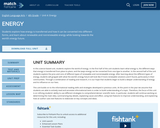
In this science-based unit, students explore the world of energy. In the first half of the unit students learn what energy is, the different ways that energy is transferred from place to place, and the ways energy can be converted from one type to another. In the second half of the unit students explore the pros and cons of different types of renewable and nonrenewable energy. After learning about the different types of energy, students will grapple with what the world’s energy future will look like if more renewable solutions aren’t found, particularly in their communities. Through a combination of reading and research, it is our hope that students begin to build a deeper understanding of energy and its influence on our lives.
This unit builds on to the informational reading skills and strategies developed in previous units. At this point in the year we assume that students are able to actively read and annotate informational texts in order to build understanding of a topic. Therefore, the focus of this unit is on refining students’ ability to use different strategies to comprehend denser scientific texts. In particular, students will continue working on determining the main idea, summarizing key details, explaining cause and effect, using text features to improve understanding, and explaining how an author uses text features to elaborate on key concepts and ideas.
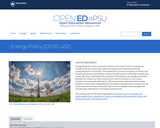
Energy policy sits at the crossroads of science and policy. And now, energy and climate policy are inextricably linked; the policies we choose have very real consequences for our climate. This intersection of science and policy is chaotic and bustles with activity motivated by various competing (and conflicting) interests and factors. We must understand the motivations driving them and bridge the divides between our reliance on fossil fuels and our need to transition to less carbon-intensive and renewable alternatives. While the science and math behind these problems is often fairly straightforward, the politics and behavioral changes are not. Come stand at this busy intersection with us as we navigate toward progressive climate policy alternatives at all scales of governance!

Media-rich textbook for an introductory English course. It covers the writing process, as well as descriptive, narrative, illustration, persuasion, and causal analysis essays.